As a fashion retailer, you don’t just sell a product. You sell an aesthetic that touches every aspect of the shopping experience.
In a fast-moving, trend-driven industry, how can your ecommerce strategy keep up? Styles come and go, new lines drop every week, and the latest viral craze can change your campaign plans overnight.
The demands of fashion merchandising mean manual site updates and painstaking product arrangement are out of the question. Keep your site in style with these time-saving ecommerce best practices for fashion retailers.
Take Control of Product Display
Use merchandising rules to dynamically arrange products throughout your store. Take control with these tips, and get the right product in front of the right shopper at the right time.
Boost Products to Reach Your Goals
Boost rules elevate your chosen products to the top of search and category pages. Use this tactic to align site-wide product arrangement with your business objectives and target audience.
For example, boost new arrivals to keep your site fresh for returning visitors, or prioritize best sellers to target new customers. Focus on high-margin products to maximize revenue, or surface discounted results to offload sale stock. Whichever approach you choose, test and optimize often.
“As soon as a certain item becomes more popular and more of a revenue-driver, it’s going to automatically move up in our pages. Likewise, if an item starts to run low on inventory, it automatically moves down. Having control over those rules, and which ones are most important to our business metrics and KPIs at any given time, has had a huge impact.”
– Emma Mcilroy, CEO of Wildfang >> Learn More About Wildfang
Hide Out-of-Stock Results
Out-of-stock products are wasted real estate on your site, so set dynamic rules to hide them from search and category pages. Products with limited size or color availability are another source of frustration for fashion shoppers. De-prioritize items with low stock levels so customers don’t repeatedly find their favorite products are unavailable in their size. GAZMAN makes excellent use of this tactic with a custom rule based on their size curve.
Pin Preferred Products
Occasionally, you might need to override site-wide boost rules to fine-tune a page aesthetic or temporarily adjust results. An intelligent merchandising solution equips you to pin your chosen products to the top of a page as needed. Badgley Mischka, for example, uses this feature to pin products featured in their email campaigns to the top of the relevant landing pages.
Geo-merchandise by Location
While your Minnesota customers seek out winter coats, Texan shoppers are on the lookout for lighter layers. How can you display relevant products and banners if your customers come from varied locations and climates? Overcome this challenge with geo-merchandising, which dynamically adapts your rules to reflect the visitor’s local weather, seasonal needs, or even sports team.
Add Visual Cues
Merchandising banners and badges create urgency and compel shoppers to act. Use your graphics wisely to maximize conversions.
Stay in Style
Capture your brand aesthetic with visually appealing banners, and switch them up regularly to keep shoppers engaged. Don’t leave last season’s looks on your homepage or product categories. Customers want to see the latest trends styled in an accessible way to inspire their next purchase.
Your latest offers and promotions also deserve a place in your merchandising banners. Take inspiration from St Frock, where a timely discount code greets shoppers as soon as they land on the homepage.
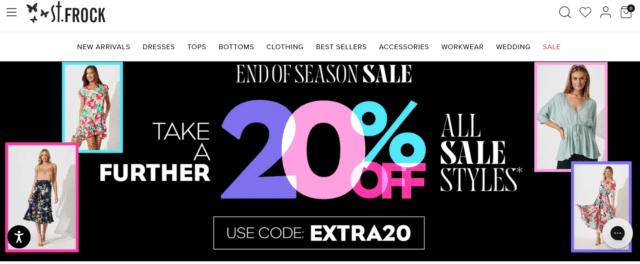
St. Frock Homepage Banner Showing Trends for an End of Season Sale
Get Inline
Banners aren’t just for the top spot on a page. Place strategic messages and offers throughout the product grid with inline banners. Whether it’s to promote your flexible payment options, sustainable practices, or express shipping, leverage inline banners to give shoppers more reasons to convert.
See these banners in action on Pair of Thieves, where free shipping is promoted alongside product results.
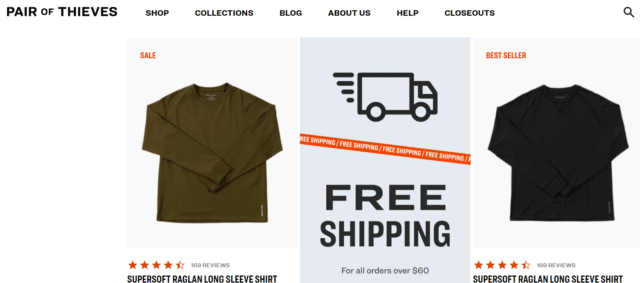
Inline Banners on a Pair of Thieves Product Page
Bring it Together with Badges
Beyond banners, use merchandising badges to spotlight products that are trending, selling fast, or on a time-limited offer. As shoppers scroll, their eyes are drawn to these visual cues that make certain products stand out.
Good American takes this approach with best seller badges that distinguish popular results in their jeans category.
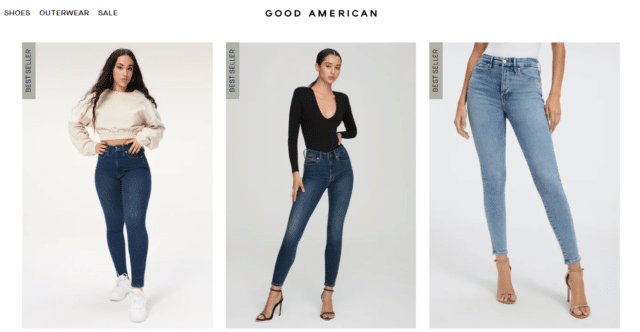
Use of Badges to Display Best Sellers on the Good American Jeans Product Page
Curate Targeted Campaigns
Merchandising is an always-on effort, complemented by a calendar of timely, targeted campaigns. Here’s how to keep on top of simultaneous promotions with minimal effort.
Go Global
Certain merchandising tactics are applicable to your entire site, all year-round. Whether it’s your tried and tested boost rules or targeted geo-merchandising banners, run these global campaigns in the background to optimize your everyday shopping experience. With the right solution, you can make sweeping, site-wide changes to this type of campaign in a matter of clicks.
Leverage Landing Pages
For those one-off initiatives or seasonal campaigns, merchandised landing pages are a game-changer. From your summer shop or winter edit, to Black Friday sales and holiday gift guides, use landing pages to merchandise products from different categories in a single shopping destination.
Landing page campaigns aren’t just for seasonal needs, either. Fabletics uses merchandised landing pages to support influencer marketing campaigns and celebrity collabs.
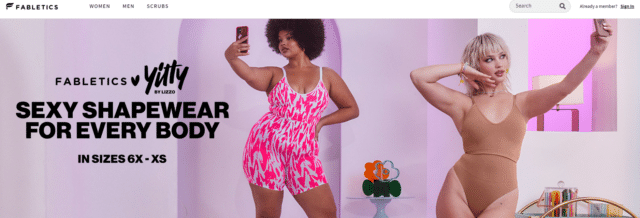
Fabletics and Yitty by Lizzo Create Landing Pages for Collections and Campaigns
Clear Your Schedule
Is there anything worse than manually setting up a new campaign, category, or landing page right before a critical launch? With merchandising scheduling, you don’t have to.
Curate your campaigns in advance – complete with banners, boost rules, and more – to facilitate robust testing and a stress-free launch. Simply set your campaign to go live and deactivate at your chosen times and watch the conversions roll in.
Make Hyper-Relevant Recommendations
Product recommendations are a must for fashion retailers. Enhance product discovery, boost conversions, and increase average order value with these three strategies.
Complete the Look
When a shopper views a product, cross-sell complementary accessories that they might otherwise miss. A customer that plans to buy a pair of pants could suddenly decide they also need the matching blazer. Someone on the lookout for a new pair of gloves may not realize you also offer hats and scarves in the same style.
Zimmermann, for example, showcases beach-friendly accessories on swimwear product pages.
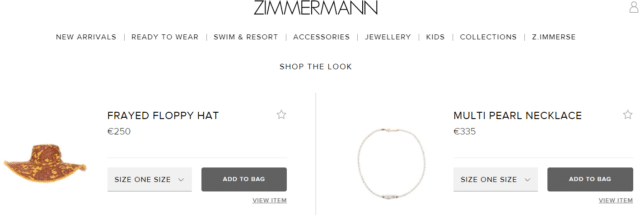
Zimmermann Displays Relevant Personalized Product Recommendations
You Might Also Like
Recommendations are also an opportunity to show shoppers more of the styles they love. For example, if a customer views a black winter coat, display similar results right on the product page so they don’t have to click back and forth to continue browsing. This form of recommendation is a clever way to discreetly upsell products at a slightly higher price, too.
BHFO takes this approach to surface similar styles of gowns on individual product pages.
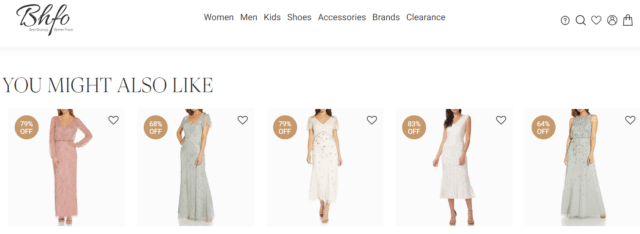
“You Might Also Like” Product Recommendations on BHFO
Just For You
Add personalization to your recommendations to suggest products based on an individual user’s order history or recently viewed items. Greet returning visitors with targeted recommendations on the homepage, or prompt a purchase with customized email recommendations. Make it personal and expand suggestions beyond the product page for the greatest impact.
Supercharge Your Search
Shoppers that go straight to your search bar have a higher intent to buy than those who browse. Does your site search return the results they’re looking for?
Predict (and Correct) Their Needs
Spelling errors are commonplace in search queries, especially among mobile shoppers on small screens. Make sure your search solution is configured to autocorrect typos and provide accurate “did you mean” suggestions.
Even better, follow Boody’s example and predict the shopper’s full search term before they even finish typing with an autocomplete drop down menu.
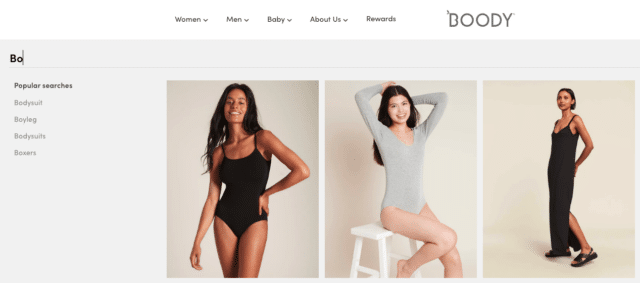
Autocomplete on Boody Displaying Popular Searches Related to “BO”
Set up Synonyms
Does your site search recognize “tshirt,” “t-shirt,” and “tee” as the same product type? Do shoppers receive the same results if they search for “swimwear” vs “bathing suits”?
Small differences in language can wreak havoc on your search results. Check your site reports for terms that lead to zero results and implement synonyms to ensure those phrases return relevant products in future. As an added tip, follow THE UPSIDE’s example:
“If we release a limited edition leopard print product and continue to see searches for ‘leopard’ after it sells out, we can add that term to the ‘animal print’ synonym to ensure the customer still finds relevant results.”
– Airi Sutherland, Head of Digital, THE UPSIDE >> Learn More About The Upside
Personalize Search Results
Did you know you can personalize a shopper’s search results? Track their on-site behavior to boost the products they are most likely to buy to the top of their search. They’ll receive the same results as every other visitor, but arranged in an order that reflects their preferences.
Deliver an Exceptional Fashion Shopping Experience
Fashion shoppers expect a striking site aesthetic and effortless shopping experience. From strategic product arrangement and targeted campaigns, to hyper-relevant recommendations and intuitive search, the success of your online store is determined by so much more than your product catalog.
To learn more about these ecommerce tools for fashion retailers, or to get custom advice for your site, get in touch with our team of experts today!




